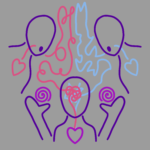Bias Blockers
Margaux Trexler
No Bias in mediation
No bias in mediation because mediators have to be neutral to serve the purpose of mediation. Here is my story with Mediator Elizabeth Franz of Humanz mediate, a mediation service provider.
During my first basic mediation training session with Elizabeth Franz, the founder of Humanz Mediate, we watched a video of a group playing a game called The Big Wind Blows. I played this game as a 12th grader while leading a 9th-grade orientation at my high school. I immediately had flashbacks of my friend and me trying to motivate a group of apprehensive fourteen-year-olds to participate in an icebreaker activity. Needless to say, it wasn’t easy.
If you haven’t played this game before, it goes something like this. A group gathers in a circle, with one person standing in the middle. The person in the middle says, “the big wind blows if…” followed by a characteristic or fact related to them. The subsequent phrase could be anything; you could say “if you have a sister,” “if you have the letter “E” in your name,” or “if you’re terrified of bumblebees.” Truly anything. Then, if that fact applies to someone standing in the circle, they have to trade spots with someone else in the circle. Whoever is the last person without a spot in the middle then has to say a fact about themselves, and the game continues.
While watching the video with Mediator Elizabeth, she asked me to watch certain group members, specifically one girl in a white shirt. She stood out to me due to her unique approach to the game. Most people play, my 12th-grade myself included, by running across the circle, actively searching for a new spot, and dodging other players in the process. But the girl in the white shirt was different. She opted for stepping into the open spots on either side of her, avoiding the chaos in the middle of the circle.
Elizabeth asked me what I thought about this girl’s choice. I reflected on my own experience playing The Big Wind Blows. I had come up with silly facts about myself and skipped across the circle, trying to make the group of timid 9th graders around me feel more comfortable. I was there to have fun, be active, and if it came down to it, make a little bit of a fool out of myself for the sake of the group bonding.
I told Elizabeth that I thought the girl seemed uninterested in the game and lazy. I never saw her smile, while others in the video could be seen laughing at other players’ frantic attempts to find a new spot and fun facts. I said if I were playing the game, I would be giving it my all, unlike the girl in the white shirt.
I was confident in my answer, but Elizabeth had another perspective. She said she thought the girl in the white shirt was playing the game intelligently. Why should that girl waste energy running across the circle when there was an empty spot right next to her? She was being strategic.
I sat and ruminated on Elizabeth’s words. I would never have thought that the girl was being strategic. All I saw was someone doing the bare minimum. My internal preference for giving your all and having fun blocked me from seeing any other possibility for the girl’s motivations.
My immediate judgment of the girl in the white shirt’s strategy in The Big Wind Blows shows how our biases can block us. We never know what someone is going through, their motivations, or their strategies for life. Maybe that girl in the white shirt just received some bad news or had particularly bad cramps that day. I’ll never know, so why pass judgment on her without answers? Just because we see a situation or an individual one way does not mean that’s what or who they are.
The lesson extends beyond a general principle for life and into mediation as well. Mediators have to be constantly checking bias and preference blocks to mediate conflicts and honor all participants neutrally. Whether the participants are energetically showing up or more reserved, mediators must reflect and treat both equally. Just because you may prefer one demeanor over another, that doesn’t mean the other one is invalid. Identifying and neutralizing your bias blockers is a key part of the role of a mediator. In my journey to becoming a mediator, I will have to identify my biases, and in this training session with Elizabeth, I started the process.
